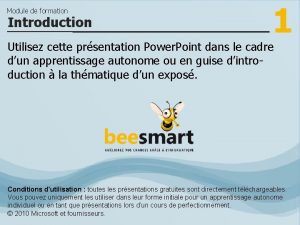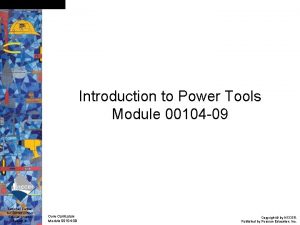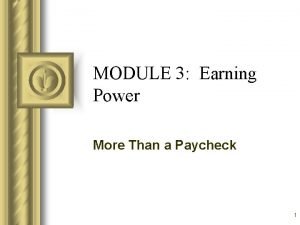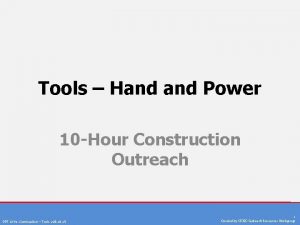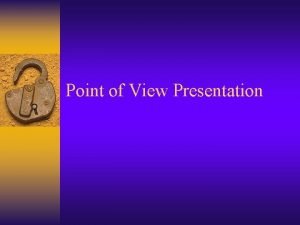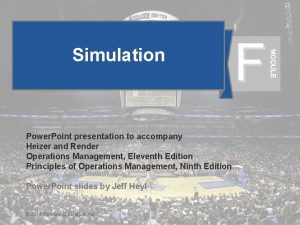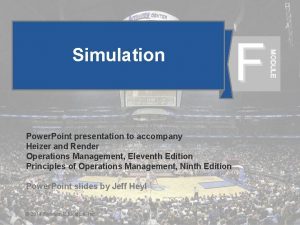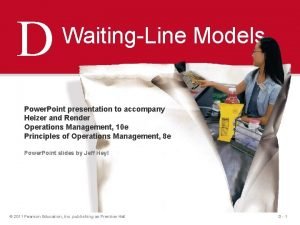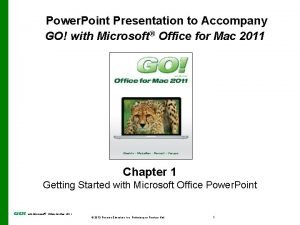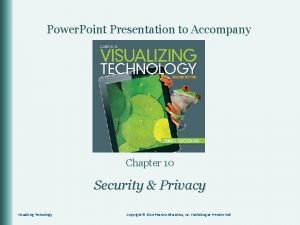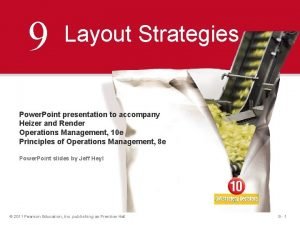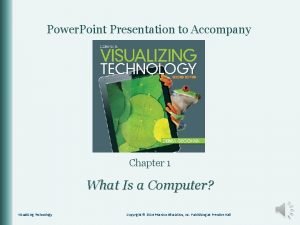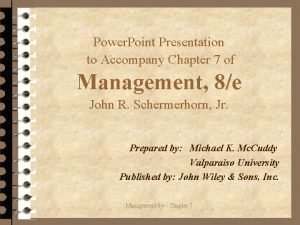F MODULE Simulation Power Point presentation to accompany


























- Slides: 26

F MODULE Simulation Power. Point presentation to accompany Heizer and Render Operations Management, Eleventh Edition Principles of Operations Management, Ninth Edition Power. Point slides by Jeff Heyl © 2014 Pearson Education, Inc. © 2014 Pearson Education, MF - 1

Outline ► ► What Is Simulation? Advantages and Disadvantages of Simulation Monte Carlo Simulation and Inventory Analysis © 2014 Pearson Education, Inc. MF - 2

Learning Objectives When you complete this chapter you should be able to: 1. List the advantages and disadvantages of modeling with simulation 2. Perform the five steps in a Monte Carlo simulation 3. Simulate an inventory problem 4. Use Excel spreadsheets to create a simulation © 2014 Pearson Education, Inc. MF - 3

Computer Simulation © 2014 Pearson Education, Inc. MF - 4

What is Simulation? ▶ An attempt to duplicate the features, appearance, and characteristics of a real system 1. To imitate a real-world situation mathematically 2. To study its properties and operating characteristics 3. To draw conclusions and make action decisions based on the results of the simulation © 2014 Pearson Education, Inc. MF - 5

Simulation Applications TABLE F. 1 Some Applications of Simulation Ambulance location and dispatching Bus scheduling Assembly-line balancing Design of library operations Parking lot and harbor design Taxi, truck, and railroad dispatching Distribution system design Production facility scheduling Scheduling aircraft Plant layout Labor-hiring decisions Capital investments Personnel scheduling Production scheduling Traffic-light timing Sales forecasting Voting pattern prediction Inventory planning and control © 2014 Pearson Education, Inc. MF - 6

To Use Simulation 1. Define the problem 2. Introduce the important variables associated with the problem 3. Construct a numerical model 4. Set up possible courses of action for testing by specifying values of variables 5. Run the experiment 6. Consider the results (possibly modifying the model or changing data inputs) 7. Decide what course of action to take © 2014 Pearson Education, Inc. MF - 7

Define problem The Process of Simulation Introduce variables Construct model Specify values of variables Conduct simulation Examine results Figure F. 1 © 2014 Pearson Education, Inc. Select best course MF - 8

Advantages of Simulation 1. Can be used to analyze large and complex real-world situations that cannot be solved by conventional models 2. Real-world complications can be included that most OM models cannot permit 3. “Time compression” is possible © 2014 Pearson Education, Inc. MF - 9

Advantages of Simulation 4. Allows “what-if” types of questions and different policy decisions can be quickly evaluated 5. Does not interfere with real-world systems © 2014 Pearson Education, Inc. MF - 10

Disadvantages of Simulation 1. Can take a long time to develop 2. It is a repetitive approach that may produce different solutions in repeated runs 3. Managers must generate all of the conditions and constraints for solutions they want to examine 4. Each simulation model is unique © 2014 Pearson Education, Inc. MF - 11

Monte Carlo Simulation The Monte Carlo method may be used when the model contains elements that exhibit chance in their behavior 1. Set up probability distributions for important variables 2. Build a cumulative probability distribution for each variable 3. Establish an interval of random numbers for each variable 4. Generate random numbers 5. Simulate a series of trials © 2014 Pearson Education, Inc. MF - 12

Probability of Demand TABLE F. 2 Demand for Barry’s Auto Tire (1) DEMAND FOR TIRES (2) FREQUENCY 0 10 10/200 =. 05 1 20 20/200 =. 10 . 15 2 40 40/200 =. 20 . 35 3 60 60/200 =. 30 . 65 4 40 40/200 =. 20 . 85 5 30 30/ 200 =. 15 1. 00 200 days © 2014 Pearson Education, Inc. (3) PROBABILITY OF OCCURRENCE (4) CUMULATIVE PROBABILITY 200/200 = 1. 00 MF - 13

Assignment of Random Numbers TABLE F. 3 The Assignment of Random-Number Intervals for Barry’s Auto Tire DAILY DEMAND PROBABILITY 0 . 05 01 through 05 1 . 10 . 15 06 through 15 2 . 20 . 35 16 through 35 3 . 30 . 65 36 through 65 4 . 20 . 85 66 through 85 5 . 15 1. 00 86 through 00 © 2014 Pearson Education, Inc. CUMULATIVE PROBABILITY INTERVAL OF RANDOM NUMBERS MF - 14

Table of Random Numbers TABLE F. 4 Table of 2 -Digit Random Numbers 52 50 60 52 05 37 27 80 69 34 82 45 53 33 55 69 81 69 32 09 98 66 37 30 77 96 74 06 48 08 33 30 63 88 45 50 59 57 14 84 88 67 02 02 84 90 60 94 83 77 © 2014 Pearson Education, Inc. MF - 15

Simulation Example 1 DAY NUMBER RANDOM NUMBER SIMULATED DAILY DEMAND 1 52 3 2 37 3 3 82 4 4 69 4 5 98 5 6 96 5 7 33 2 8 50 3 9 88 5 10 90 5 Select random numbers from Table F. 3 39 Total 10 -day demand 3. 9 Average © 2014 Pearson Education, Inc. MF - 16

Simulation Example 1 DAY NUMBER RANDOM NUMBER 1 Expected demand 2 SIMULATED DAILY DEMAND 52 3 37 3 3 82 4 4 69 4 5 98 5 6 96 5 7 33 2 8 50 3 9 88 5 10 90 5 Select random numbers from Table F. 3 39 Total 10 -day demand 3. 9 Average © 2014 Pearson Education, Inc. MF - 17

Simulation and Inventory Analysis TABLE F. 5 (1) DEMAND FOR ACE DRILL Probabilities and Random-Number Intervals for Daily Ace Drill Demand (2) FREQUENCY (3) PROBABILITY (4) CUMULATIVE PROBABILITY (5) INTERVAL OF RANDOM NUMBERS 0 15 . 05 01 through 05 1 30 . 15 06 through 15 2 60 . 20 . 35 16 through 35 3 120 . 40 . 75 36 through 75 4 45 . 15 . 90 76 through 90 5 30 . 10 1. 00 91 through 00 300 days © 2014 Pearson Education, Inc. 1. 00 MF - 18

Inventory Simulation TABLE F. 6 (1) LEAD TIME (DAYS) Probabilities and Random-Number Intervals for Reorder Lead Time (2) FREQUENCY (3) PROBABILITY (4) CUMULATIVE PROBABILITY (5) RANDOMNUMBER INTERVAL 1 10 . 20 01 through 20 2 25 . 50 . 70 21 through 70 3 15 . 30 1. 00 71 through 00 50 orders © 2014 Pearson Education, Inc. 1. 00 MF - 19

Inventory Simulation 1. Begin each simulation day by checking to see if ordered inventory has arrived. If it has, increase current inventory by the quantity ordered. 2. Generate daily demand using probability distribution and random numbers. 3. Compute ending inventory. If on-hand is insufficient to meet demand, satisfy as much as possible and note lost sales. 4. Determine whether the day's ending inventory has reached the reorder point. If it has, and there are no outstanding orders, place an order. Choose lead time using probability distribution and random numbers. © 2014 Pearson Education, Inc. MF - 20

Inventory Simulation TABLE F. 7 (1) DAY (2) UNITS RECEIVE 1 Simkin Hardware’s First Inventory Simulation. Order Quantity = 10 Units; Reorder Point = 5 Units (3) BEGIN INV (4) RANDOM NUMBER (5) DEMAND 10 06 1 (6) ENDING INV (7) LOST SALES (8) ORDER ? 9 0 No 2 0 9 63 3 6 0 No 3 0 6 57 3 3 0 Yes 4 0 3 94 5 0 2 No 5 10 10 52 3 7 0 No 6 0 7 69 3 4 0 Yes 7 0 4 32 2 2 0 No 8 0 2 30 2 0 0 No 9 10 10 48 3 7 0 No 10 0 7 88 4 3 0 Yes 41 2 Totals: © 2014 Pearson Education, Inc. (9) RANDOM NUMBER (10) LEAD TIME 02 1 33 2 14 1 MF - 21

Inventory Simulation Average 41 total units ending = 10 days inventory = 4. 1 units/day Average 2 sales lost =. 2 unit/day lost = 10 days sales Average 3 orders =. 3 order/day number of = 10 days orders placed © 2014 Pearson Education, Inc. MF - 22

Using Software in Simulation ▶ Computers are critical in simulating complex tasks ▶ General-purpose languages - BASIC, C++ ▶ Special-purpose simulation languages - GPSS, SIMSCRIPT 1. Require less programming time for large simulations 2. Usually more efficient and easier to check for errors 3. Random-number generators are built in © 2014 Pearson Education, Inc. MF - 23

Using Software in Simulation ▶ Commercial simulation programs are available for many applications - Extend, Modsim, Witness, MAP/1, Enterprise Dynamics, Simfactory, Pro. Model, Micro Saint, ARENA ▶ Spreadsheets such as Excel can be used to develop some simulations © 2014 Pearson Education, Inc. MF - 24

Using Software in Simulation Program F. 1 © 2014 Pearson Education, Inc. MF - 25

All rights reserved. No part of this publication may be reproduced, stored in a retrieval system, or transmitted, in any form or by any means, electronic, mechanical, photocopying, recording, or otherwise, without the prior written permission of the publisher. Printed in the United States of America. © 2014 Pearson Education, Inc. MF - 26
 Things that belong to salvation
Things that belong to salvation Accompany chapter 1
Accompany chapter 1 5 groups of axillary lymph nodes
5 groups of axillary lymph nodes Accompany
Accompany Ppt on hindi topics
Ppt on hindi topics Power point presentation design west vancouver
Power point presentation design west vancouver Power triangle diagram
Power triangle diagram Power bi power point
Power bi power point Point point power
Point point power C device module module 1
C device module module 1 Présentation module de formation
Présentation module de formation 00104 introduction to power tools
00104 introduction to power tools 00104 power tools
00104 power tools The power of laughter module c
The power of laughter module c Module 3 earning power
Module 3 earning power Fetal brow
Fetal brow Leopold maneuver
Leopold maneuver Power tools safety training ppt
Power tools safety training ppt Point of view presentation
Point of view presentation The starting point in a presentation
The starting point in a presentation Solar power satellites and microwave power transmission
Solar power satellites and microwave power transmission Potential power
Potential power Flex28024a
Flex28024a Dispersive power of grating formula
Dispersive power of grating formula Power of a power property
Power of a power property General power rule
General power rule Power angle curve in power system stability
Power angle curve in power system stability










